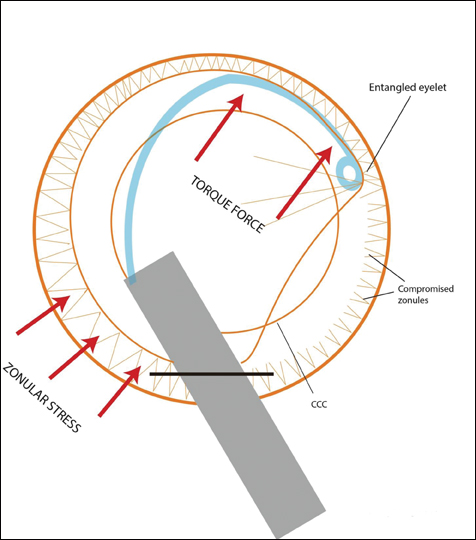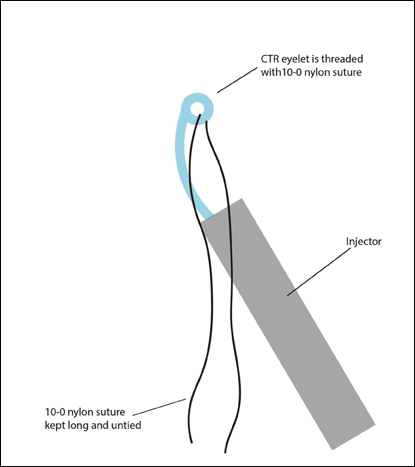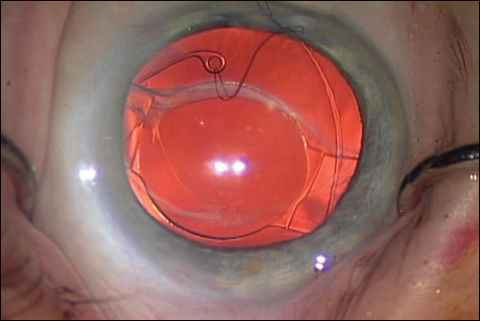Suture-guided CTR technique useful in complex surgery cases
The suture allows the surgeon to avoid complications when the capsular tension ring is inserted into the capsular bag.
Click Here to Manage Email Alerts
Advances in intraocular prosthetic devices in cataract surgery, such as capsular tension rings, capsular tension devices and capsule support hooks, have helped cataract surgery move to a higher level of surgical excellence. Surgeons can perform safe surgery in the presence of zonular weakness, zonular lysis or capsular instability and safely place a posterior chamber IOL within the capsular tension ring-stabilized capsular bag, with usually a favorable surgical outcome. In the past, such cases could end up with intracapsular cataract extraction and an anterior chamber IOL, an iris-claw IOL, a scleral-fixated posterior chamber IOL or an iris-sutured posterior chamber IOL, possibly with an anterior vitrectomy. While pseudoexfoliation and ocular trauma top the list of etiologies contributing to zonular compromise, there are other causes including hypermature cataract, intraocular neoplasms, Marfan syndrome, Weill-Marchesani syndrome, homocystinuria, retinitis pigmentosa, lens coloboma, microspherophakia and multiple vitrectomies.
Preoperative evaluation of zonular integrity should include observing the lens position and lens periphery and checking for phacodonesis. Flattening of equatorial lens capsule may reflect focal zonular weakness, while a more spherical or rounded lens margin may represent extensive zonular compromise. Surgical modifications or additions to augment safety may include a laser-assisted capsulorrhexis, lower fluidics parameters, viscodissection, multiple quadrant hydrodissection, limited nuclear rotation, micro-capsulorrhexis forceps use, and capsular tension rings or capsular hooks.
In this column, Dr. Page describes his technique of suture-assisted placement of a capsular tension ring to further augment surgical safety in such maneuvers.
Thomas “TJ” John, MD OSN Surgical Maneuvers Editor
In eyes with compromised zonules, a capsular tension ring (CTR) is an indispensable tool to stabilize the capsular bag for IOL implantation. However, inserting the CTR does not come without some inherent risks. During insertion a surgeon must be observant of torque on the capsular bag or entanglement of the leading eyelet, which may lead to catastrophic damage of the zonules if the surgeon continues to advance the CTR. The torque applied by the advancing CTR creates stress on the zonules on the opposite side of the capsular bag from the point of torque (Figure 1). Attention to the angle of attack of the leading eyelet and aiming it to the area of greatest zonular weakness may help avoid iatrogenic trauma to the zonules. However, despite a careful technique for insertion, a number of cases may result in worsening of an existing zonular dialysis or iatrogenic damage to the zonules.

Images: Page T

Figure 2. CTRs come in a variety of diameters. In general they are 2 mm smaller in their compressed state than their open state.

Figure 3. The spring tension of the CTR compressed within the capsular bag recruits strength from healthy zonules.
A CTR is referred to as having two diameters, one in the open and the other in the compressed state. Generally speaking, the CTR will have a diameter of “X” mm in the open state, and in the compressed state it will be 2 mm smaller in diameter, or “X–2” mm (Figure 2). For example, a CTR used for normal to myopic eyes has an open diameter of 13 mm and a compressed diameter of 11 mm. Because the diameter of the open CTR is greater than the diameter of the capsular bag, tension will occur across the capsular bag, recruiting the strength of the intact zonules. The CTR automatically expands as it enters the fornix of the capsular bag to its largest possible diameter based on its size and spring constant (Figure 3).

To circumvent complications that may occur as the CTR is inserted into the capsular bag, a simple technique of placing a suture in the leading eyelet will help to mitigate torque on the zonules and the potential for entanglement during CTR insertion.
The tools required for this technique include a CTR, a 10-0 suture and a micro-grasper. The CTR eyelets are large enough to easily pass a 10-0 suture. After the suture is passed through the leading eyelet, the needle may be cut off; however, the suture should be kept long (a few inches). The CTR is now prepared as a suture-guided CTR (SGCTR) (Figure 4).
Adequately filling the capsular bag with an ophthalmic viscosurgical device is critical to avoid unsupported capsular fornix from folding over upon itself where the risk of entanglement is highest. Once the bag is filled, the leading eyelet with suture is introduced into the bag. As the SGCTR is inserted, gentle traction may be applied to the suture using a micro-grasper guiding the leading eyelet centrally to mitigate stress on the zonules.

During insertion of the CTR, the surgeon must be vigilant to look for the visual cues of CTR entanglement and torque. Key indicators are displacement of the capsulorrhexis and abnormal bending of the CTR as it exits the inserter. An advantage of using the SGCTR is that the suture indicates the position of the leading eyelet, which is otherwise hidden below the iris as it advances. If the suture progress halts as the plunger is deployed, entanglement should be suspected. The micro-grasper may be used to pull the SGCTR centrally to alleviate entanglement.
The same maneuver may be applied if the dialysis appears to be extending during insertion of the CTR. Extension of the dialysis or creation of an iatrogenic dialysis should occur approximately 180° away from the area of torque applied by the advancing CTR to the fornix of the capsular bag. The SGCTR gives the surgeon control within the eye to achieve different angles of tension to guide the SGCTR during insertion. If the proper angle cannot be achieved, a second paracentesis may be made for the micro-grasper.
After the CTR has been safely and fully deployed, the suture will remain in the leading eyelet as it comes to rest in the fornix of the capsular bag. The suture can be cut at the wound and simply pulled on one end to remove it from the eyelet.
Powered by Corcoran Consulting Group.
Read about reimbursement related to complex cataract surgery. Link here.
In summary, I have been using this technique for several years and have found it to be especially useful in cases in which the capsular bag tends to fold upon itself due to poor support or in cases in which I need to place a CTR in an eye to reposition an IOL (Figure 5). The suture is a tremendous help to assist the CTR past areas of fibrotic capsule and haptic adherence. Finally, if a CTR were to dislodge into the posterior segment, the suture would serve as a safety mechanism for retrieval.
- References:
- Buttanri IB, et al. J Cataract Refract Surg. 2012;doi:10.1016/j.jcrs.2011.10.029.
- Celik E, et al. J Fr Ophtalmol. 2015;doi:10.1016/j.jfo.2015.05.007.
- Page TP. J Cataract Refract Surg. 2015;doi:10.1016/j.jcrs.2015.08.004.
- Rai G, et al. J Clin Diagn Res. 2015;doi:10.7860/JCDR/2015/10425.6999.
- Tataru CP, et al. Eur J Ophthalmol. 2016;doi:10.5301/ejo.5000613.
- Weber CH, et al. Curr Opin Ophthalmol. 2015;doi:10.1097/ICU.0000000000000118.
- For more information:
- Tim Page, MD, can be reached at Oakland Ophthalmic Surgery, 800 S. Adams Road, Suite 201, Birmingham, MI 48009; email: tpagemd@yahoo.com.
- Edited by Thomas “TJ” John, MD, a clinical associate professor at Loyola University at Chicago and in private practice in Oak Brook, Tinley Park and Oak Lawn, Ill. He can be reached at email: tjcornea@gmail.com.
Disclosures: Page reports he holds a provisional patent on a CTR design and other patents related to lens-stabilizing devices. John reports no relevant financial disclosures.
